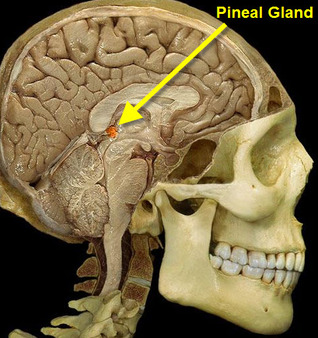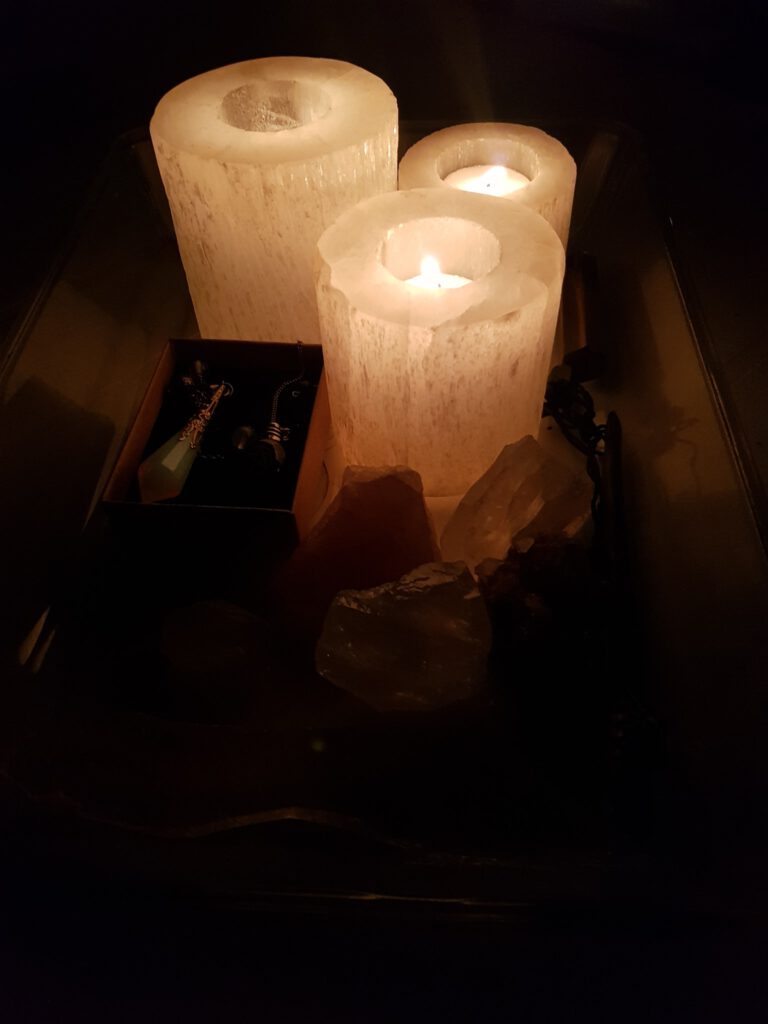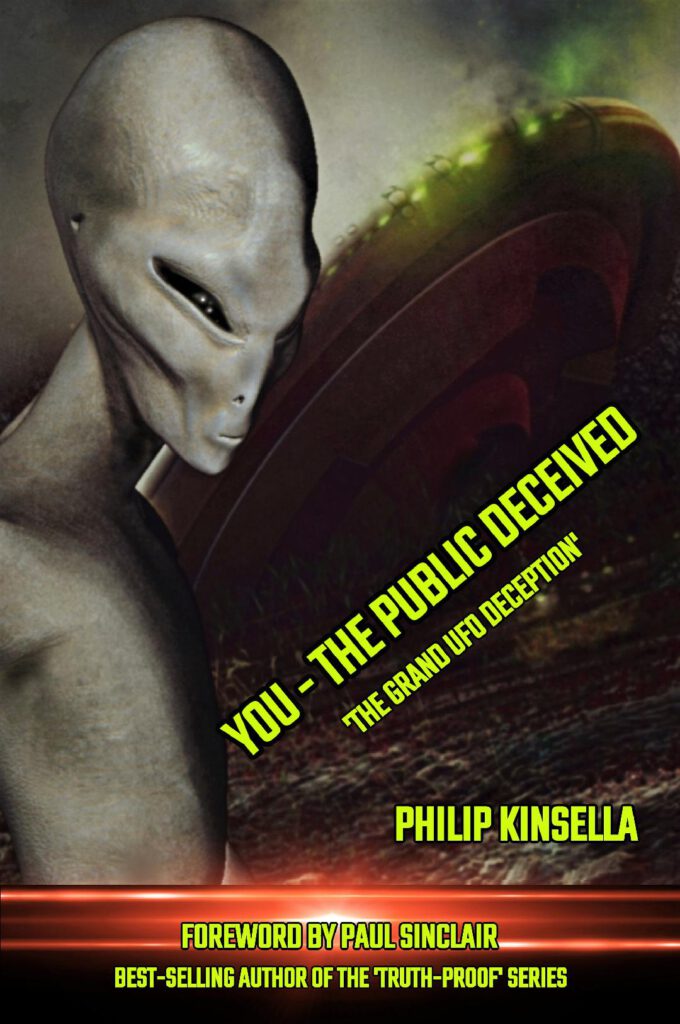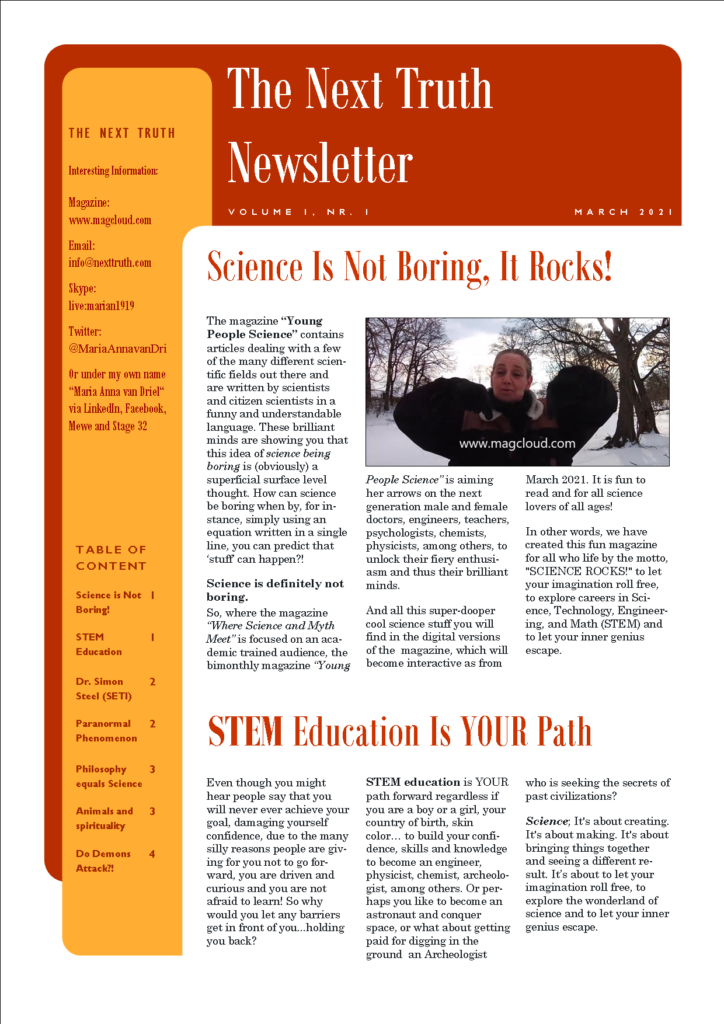Ghosts; Do They Hide in the Light?
By Maria Anna van Driel
A ghostly apparition walking through the wall, an odd shaped craft hovering in the sky or strong ripples on the surface of a lake indicating that there might be a sea monster swimming by… even though many people have seen and reported these rare but remarkable events, they do not have an explanation for what they have witnessed.
Are those, in the dark hiding, eerie shadows, truly disembodied humans who are lost or, is this an effect of Sleep Paralysis.
Is walking through a forest at night only scary because we are breathing in these, released by the trees, small amounts of methane gas while the pineal gland in your brain is detecting the ultra– and infra sound-waves are bouncing off on the trees after it has released by your own body? Or is there something malevolent hiding behind the shrubs, waiting for you to become its prey?!
Hum, that is indeed a fascinating question. So, let’s imagine that we are standing in a forest with trees all around us. Odd as it might sound but these trees have the ability of releasing a kind of resonance what can ‘communicate’ with your personal frequencies which can turn into that infamous fear frequency sending shivers down your spine.
Did you know that trees have the capability of releasing CH4, aka methane gas? A gas some say is one of the sources of today’s global warming.
Not only do trees poop Methane, they also contain liquid crystal in which a piezo-electrical effect can be observed when encountering an ambience of bright light or a heat (electrical) source. Both of these source is what you are carrying when walking a dark forest…your flash light and your body what is now electrical charged by means of the mind is entering a fight-or-flight state.
The small amounts of the odorless methane gas released by the trees around you might be just enough for you to see creepy plasma clouds forming containing photo-generated electrons which are brought together by a piezoelectric effect, dancing on the surface of natural piezoelectric (semi)conductors.
In neuroscience (or neurobiology) it is well known that the pineal gland becomes active, or is waking up so to speak, once its host is in a dark environment meaning, you being active during those hours of the day in where UV-light is not present in large amounts. Walking this darkness means that you can’t rely on your eyesight anymore what converts your body into a biological radar devise emitting sound-waves in order not to bump into anything or, to survive any dangerous situations heading your direction with high speed.
These ultra- and infra sound-waves your body is emitting, are bouncing off on the objects in your surrounding and, sometimes, have a behavior of returning back to you as a relativistic microwave and creating this chilling feeling of static electricity
You, now acting as a human radar devise, breathing small amounts of odorless methane gas as well as sensing the vibrations of the trees and returning microwaves, which are communicating with your brain, have resulted in a blood-curdling form of vivid hallucinations while it is being combined with a personal fear frequency based on creepy stories you once have read or watched via You Tube or Netflix.
Suddenly you are right in the middle of a spine-chilling situation what seems to be written by Alfred Hitchcock himself! This effect in sensing ‘things’ which seem to have no clear and visible source is based on inaudible to the ear sound-waves and chemical reactions and is one of the two ingredients of nature creating ghostly apparitions in a dark forest.
A second ingredient to create this blood-curdling effect falls in the range of an unnatural source. By means of an ambiance of LED light the liquid crystals inside the trees are triggered and create an effect of being elastic. Aka the expansion and shrinking of crystals what is giving them the ability to record and play vague but hearable sound effects and even create visible images.

Like a laser directed to a LP made of wood, LED-light can function similar to a laser, faint but not impossible.
Imagine walking through this dark forest while carrying a torch with LED-light … you will instantly understand which kind of effects this bright light source can create without your awareness. Being focused on, for instance, a paranormal investigation and not on the, seemingly, logical reactions when certain elements are being brought together, a creepy surrounding containing real ghostly effects has being created unintentional which can scare the hell out of you when it is combined with your personal fears.
I am wondering, what will be the effect seen, or sensed, when we are we adding an extra element to this natural event…a stressed cellular memory?
Sasquatch; Legend Meets Science
An interview with Idaho State University’s Professor of Anatomy and Anthropology, D. Jeffery Meldrum
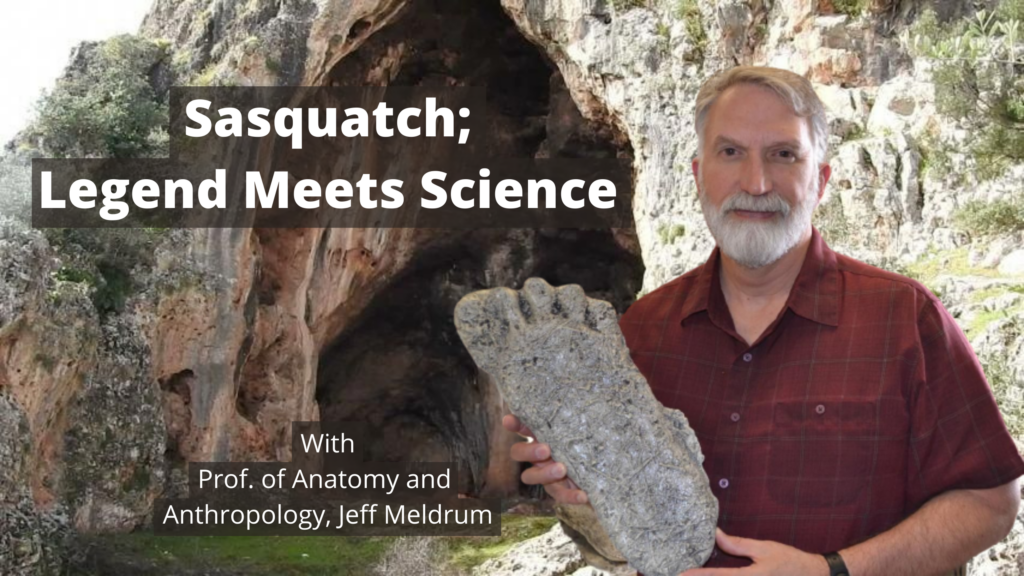
Every part of the world has its legends.
The Lakota believed in a powerful, burly figure they called “Chiye-Tanka”, or “Big Elder Brother”. The Eskimos called it “bushman”. The Colville Indians call him “Sasquatch” and the Hoopas of northern California call him “Omar”.
In 1604, French navigator Samuel de Champlain ominously described a frightful monster, what bears the name “Gougou”. In 1811, explorer David Thompson was hiking through the Rockies when he stumbled upon some seriously massive footprints, while an 1884 edition of a British Columbia newspaper called ‘The Daily Colonist’ reported the capture of a young, gorilla-like primate called “Jacko.” In 1924, a group of miners in Washington claimed to have been besieged all night long by a troop of hairy ape-man in a chasm now known as “Ape Canyon“.
Is it a bear? Could it possibly be some kind of giant ape? Could it even be some kind of ancient hominid, a member of the human family like Neanderthals that were thought to be extinct or…could it be a hoax.
Bigfoot, Yeti, sasquatch… It strikes fear and the imagination. Is it real or myth and why hasn’t anyone captured a Bigfoot. With all the leading technology scientists have today, why haven’t they found definitive evidence?
I am your host Maria Anna van Driel… and you’re listening to “The Next Truth; Where Science and Myth Meet” and this week I am speaking with Idaho State University‘s Professor of Anatomy and Anthropology, Jeff Meldrum about the science behind Bigfoot. Is there compelling evidence of Bigfoot being real.
[Top]The Future of Communication
In the digital age, technology is transforming how and what we communicate.
By guest writer Dr. Vyvyan Evans
The future is notoriously difficult to predict. For instance, in one scene from the cult classic sci-fi movie Blade Runner, the main character, Deckard, played by Harrison Ford, is in a bar. He makes a phone call to Rachel, with whom he’s falling in love, and invites her to join him for a drink. But while the future Los Angeles involves off-world colonies, cyborgs, or “replicants” as they are termed, and hover cars, Deckard places the call from a hard-wired “Vid” phone on the wall. Apparently, foreseeing the invention of mobile phones was a step too far for the 1982 movie.

Future tech and communication
Predicting the future is even thornier when considering human communication. From the perspective of technological innovation, we are living in a digital age: technology is transforming the ways we communicate with one another, and interact with the world around us. Meanwhile, other technological pipe dreams that were once only the preserve of science fiction are now becoming reality.
For instance, John Anderton, the character played by Tom Cruise in the 2002 movie Minority Report—originally a short story by Philip K. Dick, as was Blade Runner—wears a data glove, providing a sophisticated gesture-based interface system. But touch-based computing is now de rigueur, with the pinch, pull, and swipe features of Apple iPads and iPhones having led the way in the 2000s. In computer gaming, the Wii in 2006, and later, Microsoft Kinect consoles developed similar ways of interacting and controlling virtual characters and actions. Devices such as these are surely but a prelude of what is to come.
MIT computer scientist John Underkoffler predicted, in his 2010 TED talk, that virtual touch-based computing, à la Minority Report, is the future of human-computer interfaces; and at the time of writing, he is leading the development of an immersive human-computer interface environment that aims to fully replicate the science fiction of fully intuitive gesture-based systems.
Perhaps an even more exciting area of research, one that will transform how we communicate with computers over the longer term, is so-called brain-computer interfaces. In the 1995 film Johnny Mnemonic—a cyberpunk action thriller, based on the short story by William Gibson—the protagonist, played by Keanu Reeves, wears a cybernetic brain implant that stores information that can be extracted.

Today’s research on brain-computer interfaces works on a related idea: the brain makes use of electrical signals—an electrical code—to transmit and process information. For instance, sensory information, such as light and sound, harvested by the eyes and ears, is transduced into an electrical nerve impulse that the brain can process. Research on brain-computer interfaces works on the same principle—the idea is that as the brain runs on electrical signals, and assuming these can be accurately read, then the signals should allow us to communicate with external devices via the transmission of electrical impulses directly from the brain. For instance, it should be possible, at least in theory, to harness the brain signals that move your arm and hand to control a robotic arm to, say, pick up a cup of coffee.
Research of this kind is ongoing. It is already becoming possible for amputees to use prosthetic limbs with the aid of computer software; and the aim is to interpret the brain’s electric signals—to control action through thought. In research undertaken by the U.S. government’s Defense Advanced Research Projects Agency (DARPA), subjects who have lost limbs are now able to ‘feel’ sensations, due to electronic communication between ‘bionic’ prosthetics and the brain. This works by using microprocessors in the bionic limb to ‘complete’ the brain’s neural circuit. Outside such specialised research venues, cochlear implants, allowing the hard of hearing to hear, are currently the most widely available use for this technology. The principle enables brain signals to communicate with the implant, thereby overcoming the damaged part of the ear. In the future, it may be possible for implants in the brain to allow us to communicate directly with and control a wide array of devices, using the power of thought alone, as recently advocated by Elon Musk’s Neuralink project, which proposes embedding microchips into the human brain.
In terms of interpersonal communication, some of the earliest predictions about mobile or virtual communication have come true. The hand-held communicators used by Captain Kirk and Mr. Spock in the original 1970s episodes of Star Trek are essentially hands-free mobile devices, with Bluetooth earpieces. That said, contemporary mobile phones do, nevertheless, require earth-orbiting satellites; hence, their communication range does not encompass subspace transmission, and as such, is not intergalactic—just yet.
Computers and smartphones now come with fixed cameras as standard. This means that we can see the person we are talking to, in real time—media apps such as FaceTime and Skype are cases in point. The next step, perhaps, is the so-called telepresence robot. These are mobile units that host a camera and speaker that can be controlled remotely by someone whose voice and image can be projected. And the virtual person can not only see, via their remote camera, but also follow around and otherwise interact with the person with whom they are conversing. The scope for teleconferencing, and ‘remote’ tours of a specific venue, such as visiting a real-estate proposition, a new factory, or a construction site, are obvious. While today’s telepresence robots are not cheap, the cost is likely to come down and the systems will improve as the technology advances.
The Ratchet Effect
The rapidly changing face of communication is underpinned by what has been termed the ratchet effect. The idea is that culture provides a complex network of shared knowledge, systems, behaviours, and practices. This means that by being born into a given culture, shared knowledge is not something we have to learn anew; rather, and paraphrasing the words of Sir Isaac Newton, we stand on the shoulders of previous generations in order to build up and further advance our knowledge base, including technological developments. Each generation takes the developments of the previous one and extends them; and hey presto, in an increasingly short amount of time, this ratchets up the complexity of the technological advances that see the light of day.
To illustrate, let’s take a whistle-stop tour of some of the headline technological developments of the 20th century. The century began with the infancy of airplanes, automobiles, and radio; it ended with space rockets, space stations, computers, mobile phones, and, in 1997, the advent of wireless (Wi-Fi) internet. The 21st century opened with the launch of mobile internet capability, with so-called third-generation or 3G wireless mobile telecommunications. Today, with 4G and beyond, we take the internet-everywhere almost for granted.
Immediacy and reach: The transformational nature of digital modes of communication
It is doubtless true that the digital age has transformed the nature of human communication. Nowhere is this more evident than in terms of the immediacy and reach afforded by digital forms of communication.
In terms of immediacy, social media updates, and instant messaging enable instantaneous communication. Prior to the advent of digital communication technology, communication with those with whom we were not physically co-located required travel, or correspondence via snail mail. A letter to a person in the next town might take a day or two to arrive. But today we can communicate with those on the other side of the world in real time, even without picking up the phone.
And in terms of reach, the immediacy of our communications reaches an unprecedented number of people, determined by our number of friends on Facebook, followers on Twitter, and connections on LinkedIn, to mention only three popular social media platforms.
The notion of reach, is especially striking, as digital technology is transforming the nature of the social networks with whom we can communicate. In analogue communication, a social network can be thought of as having a limit that relates to Dunbar’s Number: around 150. This is a cognitive limit to the number of people with whom one can maintain stable social relationships—proposed by Robin Dunbar, who found a correlation between primate brain size and average social group size.
In contrast, in digital communication, our social network is only constrained, in principle, by the number of people who have access to the internet—around 3.2 billion people and counting. On Twitter, for instance, Barack Obama reaches over 100 million people with each tweet.
New systems of communication: Emoji
In addition to transforming the nature of our communicative reach, the digital age is also providing opportunities and innovations in terms of new forms and systems of communication. And while the underlying principles of communication remain fundamentally the same, how we communicate is and will continue to be impacted as a consequence.
A salient case in point, in the early part of the 21st century has been the emergence of emoji as a global means of communication. In my book, The Emoji Code, I made the following argument. Technology is not changing the cooperative impulse that underpins communication. Nor is it changing the principles that undergird systems of communication. Rather, technology provides new avenues and opportunities; it provides new channels of communication.
But in certain respects, these channels can be impoverished, initially at least, in terms of current systems of communication. Face-to-face spoken interaction is multimodal. It is a fully immersed experience, in which participants communicate using the full panoply of modes, and make use of linguistic, paralinguistic, kinesic, and visual systems of communication. Patterns of eye gaze and prosody convey different aspects of social meaning that fill out the linguistic meaning.
In contrast, abbreviated textspeak is impoverished in the multimodality stakes. And this is where emoji has come into its own; it has begun to allow digital communication to replicate some of the non-verbal communicative cues available to face-to-face interaction. It is not that emoji represents a step-change in communication; rather, and somewhat more prosaically, emoji is providing an inevitable step in plugging a gap in a new channel of communication: the digital.
Without emoji, part of what provides a well-rounded communicative message is missing. And given that textspeak is a visual form of representation, it is inevitable that pictographic representations should help provide some of the paralinguistic and kinesic cues.
Emoji provides a starting point to provide a multimodal system of communication, fit for purpose, in the digital age. We might speculate on how emoji will develop—in the short term, animated, avatar-like emojis might be one way in which textspeak can be further enhanced by multimodal cues. Facial expressions and gestures are what make us who we are: let’s see it, and not be afraid of seeing it, in emoji!
Whatever the next stage in the evolution of emoji and, indeed, other emerging systems of digital communication, the driver is, ultimately, the cooperative intelligence that makes us the unparalleled communicators we are. Emoji makes us more effective communicators in our 21st-century world of communication.
[Top]A New Dutch Reiki Practice “Mystic Ways”
By guest writer Veronique Lamers

Sitting outside in the sun with my laptop in front of me, I would like to write a couple of words concerning my Reiki Practice, which I hope to open very soon, and briefly tell you where my journey in Healing began. How it came about that I embraced it at already a young age.
Spiritual Healing runs in our family. My father used to put his hands on those areas where we felt physical pain. I remember me falling on my knee and my father was holding his hand over my knee and I felt the pain subsiding. This event had left a deep impression with me. Later in time I realized that I could do this myself as well but, at that point in my life, I didn’t know how to deal (work) with it in a correct and controlled manner.
As far as I can remember I always had a particular energy radiating from my hands what had a warm and tingling feeling. I even managed to make electric devices run wild or even create a malfunction. An ability what is not really useful if you go to a casino with your loved one and you set off the alarm of a slot machine.
Anyway, the true reason I started to study Reiki-Ushi. was because of my husband. He has OPS, painter’s disease. This is a disease what is accompanied by a lot of headaches and physical limitations. Each time I put my hand on his head he start to feel calm and his pain reduced dramatically.
I dove into the ancient knowledge of Reiki – Usui and started participating in those courses.
The last initiation, the 3rd degree, Masters, was given by a good friend what I experienced as very intense and special. During my Reiki courses I also created the business page “Mystic Ways” on Face Book.
At I first started with remote healings and healings which I carried out at the homes of my clients on a folding couch that I was carrying with me all the time. This way I was able to treat clients on a regularly base with a lot of love. This radiating love I always have send the client after a remote healing treatment as well.
Reiki is something what is woven in my heart and I really want to continue this. So, I have taken this exciting step to furnish a small but professional space in my home so that, once this terrifying virus, aka Covid, is reduced in its presence, I can receive people who will benefit from my spiritual healings.
Reiki is a long term learning process and I would love to gain the diploma of “magnetization” as well as more types of Reiki initiations. This way I can be even more present for those people who need it and at the same time continue to relieve my husband from those moments in where he experiences physical pains.
I hope to have given you a little insight into why I love doing this so much!
Lots of love, Veronique
[Top]Walking the Thin Line of Reality
By Maria anna van Driel, (a fictional short story)
The evening has fallen and the darkness of the night is grabbing hold of the evening more and more. This unnatural white light spread by a lamp post standing across the road is creating a distorted image in the cold rainwater that is gathering in small puddles on the ashes.

Barefooted she walks along the road, her head bend slightly to keep the rain pelting her face. Her jeans, white T-shirt and denim jacket are soaked from the rain what, like a transparent curtain, is surrounding her. In a haze she sees a car rushing past carrying optical signals. Disorientated, cold and exhausted she wraps her arms a little tighter around her chest. Her long dark hair hanging over her shoulders like frayed rope. The night is grim and, with every step she takes, the rain becomes colder and the wind stronger. How she would love to lie down, fall asleep, and forget all the misery of the past hour.
Her body seems to work on autopilot and has taken over her mind, and with every beat of her heart, a new rush of survival-drift runs through her veins.
Another car approaches her, slows down and drives at walking pace with her. The window opens, ‘What happened?’, the driver asks. ‘Can I help you with anything?’ She stops walking but does not look at the man behind the wheel. ‘Could I perhaps offer you a ride?’ he asks. With her head still slightly bend and her arms tightly wrapped around her chest, she passes in front of the car and silently gets in. The gray fabric upholstery of the passenger seat eagerly absorbs the rainwater from her drenched clothing. Within a few seconds the chair has turned dark gray in color. ‘What is your name?’ he asks but is not receiving any answer.
Her hair, weighed down by the rain, falls forward covering her face. He presses the button of the interior lighting and sees that her T-shirt contains watered-down traces of blood. ‘Are you hurt?’ he asks concerned. He carefully removes the hair from her face, ‘My name is Alex, will you tell me yours’, he asks in a friendly tone. Alex can see several small and shallow cuts on her face from which blood is dripping. ‘Who did this? What happened to you ?’ But his passenger does not move and remains silent. The only movement he can trace is the shaking of her body as she fights an incipient hypothermia. Alex grabs his coat from the backseat and drapes it around her shoulders. ‘The hospital is nearby’, he says and turns the car heating on the highest setting.

After twenty minutes they drive into the hospital parking lot. Alex, who has already called the hospital on the way, drives without any hesitation to the entrance of the emergency room. Two nurses rush towards them pushing forwards a stretcher. Alex gets out of his car and says hurriedly to the nurses, ‘She has hypothermia and several small cuts on her face. Prepare an examining room for her and call the police so they can find out her identity.’
One of the nurses guides the still unknown woman through the spotless white hallway to one of the treatment rooms. Shortly after Alex walks in. He has exchanged his sweater for a three-quarter-length white coat, a pager and a stethoscope. Dr. A. Green she reads on his nameplate. Alex rolls a chair over to the hospital bed and sits in front of his patient. ‘Let me introduce myself properly, I am Dr. Green. I see they have given you clean and dry clothes. Will you tell me what your name is?’ She lifts her head and looks at him with a frightened look. ‘Melanie’, she whispers, pressing her arms firmly against her chest.
‘Is the blood on your t-shirt coming from your chest?’ Melanie slowly shakes her head as a sign that she doesn’t feel any pain. ‘Will you tell me your last name, so I can contact your family.’ Melanie lowers her head.
A male nurse sticks his head through the doorway, ‘I have been in contact with the police and they are on their way.’ ‘Thank you.’ Alex says while reaching for a clean gauze from a drawer behind him. ‘I am going to clean your face so I can see if any of these cuts have to be stitched.’ Melanie agrees with a gentle nod in silence, as if she is afraid to make a noise.
Alex supports Melanie’s chin with his hand and begins wiping away the blood from around the cuts. Then the pager in his coat goes off. He looks at the number that has appeared in the small display… ‘I will be right back, I have to make a call to my brother. He is the sheriff at the station.’ Melanie looks startled, grabs Alex by the arm and start shaking her head violently.’ ‘Don’t be afraid, Alex says, you are safe here.’ With a slight hesitation she lets go of his arm and bends her head again as if she is giving up.
Alex walks back to where he left Melanie 15 minutes earlier. Suddenly a strange feeling of dread creeps over him. He looks into a now dark treatment room. Then a bright flash of light with a loud bang almost immediately after as if someone fired a firearm. “Melanie!” he shouts and runs into the treatment room where the sound of the fluorescent tubes, flickering on and off, can be heard. On the empty hospital bed, like a silent witness, a shining yellow police badge is laying, reading the name ‘Green’.

One hour earlier…
Bleeding profusely, she sits in a narrow dead end alley, in the pouring rain of New York.
‘Is this how it is all going to end?’ she thinks and frowns indignantly. She leans against the iron garbage container that rests against the outside wall of the pizzeria. Her hair is soaked and hanging over her shoulders like frayed black rope. Her T-shirts and denim jacket are slowly absorbing the blood pouring out of the wound in her chest.
Dazed, she watches the raindrops fall down from the black iron fire escape and burst onto a pair of garbage bags. In the distance she hears two cars come to a stop in quick succession with their tires skidding in front of the only entrance to the alley. The bright light from the headlamps creates a grim and cold image in the alley. She hears the car doors slam and the voices of the men looking for her.
She tries to pull her legs towards her but her jeans has absorbed too much rainwater. Exhausted from the chase, she let her head rest on her shoulder. Her legs fall back into the shallow pool of rainwater she sit in and hears the water splashing when her legs hit the cold wet ground, but she doesn’t mind anymore.
Breathing becomes more difficult. The pain in her chest intensifies with every breath of oxygen she takes. She tries to suppress the pain by crossing her arms around her chest.
The red and blue light from the optical signal on the roofs of the police cars reverberate like a glare against the wet walls. Two police officers are carefully walking into the narrow alley with their weapons drawn. One of the detectives has her in sight and with his firearm drawn, he walks towards her. “She is over here!” He shouts to his colleagues who are now running in his direction.
In a haze she hears the splashing sound of the rainwater caused by their shoes while approaching her. Instinctively she reaches for the small firearm lying next to her in a shallow pool of water. A stabbing pain shoots through her chest as she tries to raise her arm. She looks glassily at the young police officer standing in front of her. Slowly the image starts to fade and her eyes get heavier. ‘Officer down, officer down!, he shouts, ‘call an ambulance, she got hit!’
[Top]Does Our Consciousness Holds the Key to a More Fulfilling Life on Every Level?
With philosopher, teacher and internationally renowned consciousness researcher, Justin Faermen
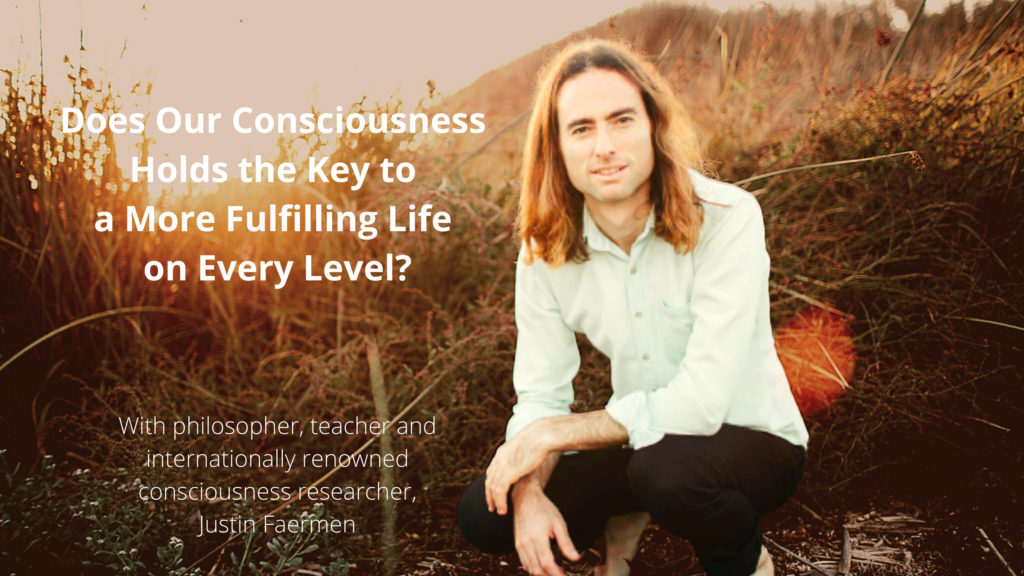
“Are you sure/That we are awake? It seems to me/That yet we sleep, we dream”
William Shakespeare, among others, already spoke about the different states of consciousness. Still, none have yet a clue what this state of mind truly is or, why we are in the possession of it.
Simply said, consciousness is “sentience of internal and/or external existence.” But despite millennia of analyses, definitions, explanations and debates by philosophers and scientists, consciousness remains a mysterious puzzle.
Is conscious the true reality? And if so, who is perceiving who? Are we perceiving consciousness or is consciousness perceiving us?
I am your host Maria Anna van Driel… and you’re listening to “The Next Truth; Where Science and Myth Meet”… and this week I am speaking with teacher, philosopher, internationally renowned consciousness researcher Justin Faerman … about what consciousness is, why we posses it and, how we can apply the knowledge received from our consciousness to our life and daily activities.
[Top]Does the Human Brain Serves as the Conduit for the Flow of Information from Alternate Realities?
With radio host, UFO investigator and author, Philip Kinsella
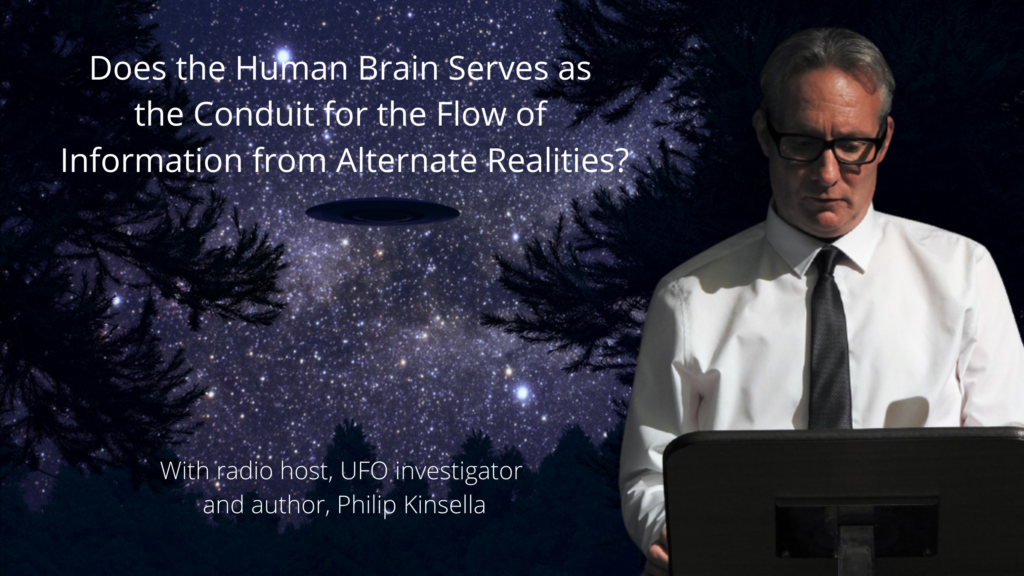
We often wonder whether or not we are alone in this universe. Pondering of the question, “If life arose relatively quickly on Earth, could it then be common in the universe?”
It is indeed promising, hearing scientists say that some bodies in the Solar System have the potential for an environment in which extraterrestrial life can exist, particularly those with possible subsurface oceans.
But what are the basic requirements for life? Could life have arisen outside the solar system? Perhaps thermodynamically, photosynthesis based on stellar radiation may be the optimal source of energy for extraterrestrial life to rise.
Many scientists search for bio-signatures within the Solar System by studying planetary surfaces and examining meteorites. Some even claim to have identified evidence that microbial life has existed on Mars. Still, the exact origin of life remains an unfathomable mystery, however this does not mean that it will always remains so.
I am your host Maria Anna van Driel… and you’re listening to “The Next Truth; Where Science and Myth Meet”… and this week I am speaking with clairvoyant medium, UFO researcher and co-host of the radio show “Twin Souls”, Philip Kinsella…about, how likely is the evolution of intelligent life outside the borders of our cosmic freezer?
[Top]The Next Truth Newsletter
Download the very first interactive Newsletter of The Next Truth and let your curiosity run free!
“Scientist”…I bet the first image that comes to mind is an intelligent man or woman wearing a white lab-coat and goggles while mixing odd looking and bubbling liquids in a laboratory. Or, someone writing, on a blackboard, the most complicated formulas which seem to come straight from an alien language. 😲
If you would ask someone what is “Science”, you most likely gain an answer what is similar to; “Science comes from the Latin word scientia, meaning “knowledge”. It is a systematic enterprise that builds and organizes knowledge in the form of testable explanations and predictions about the universe. 🤨
Whooow…slow down a bit! Even though the above where and are correct, it does not quite seem to answer you question of what science is, what is it and, especially, how you can become an expert in that particular scientific field what has captured your deep interest.
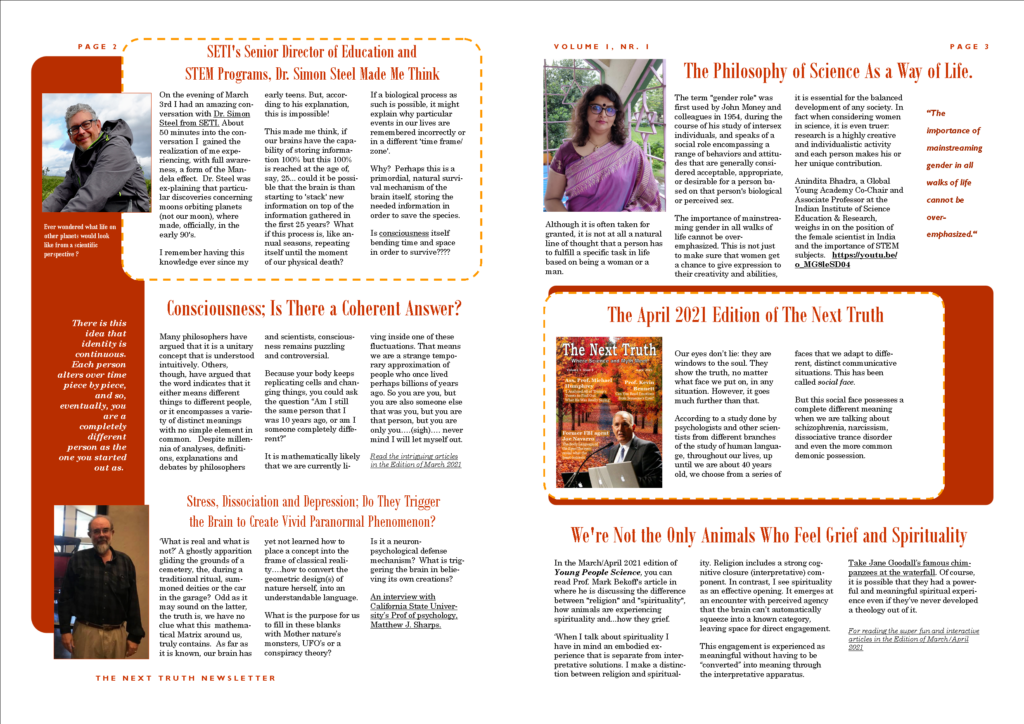
Together with renowned scientists and citizen scientists, The Next Truth is tapping-in those corners of science which gives you the opportunity to explore those questions you do not easily find in the myriad books libraries have in their possession.
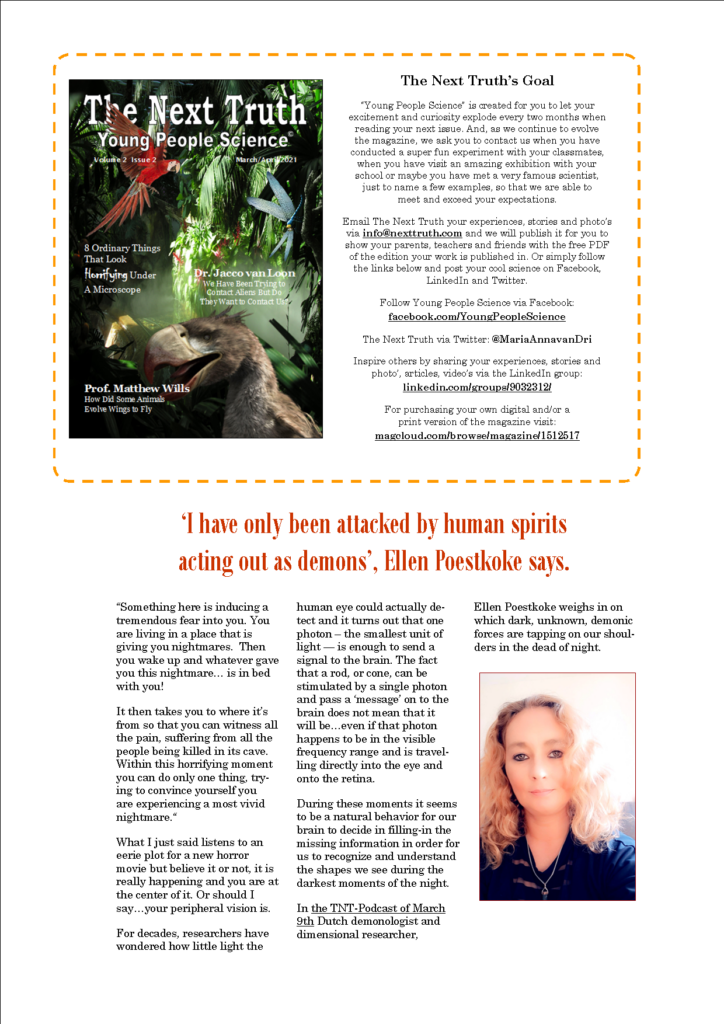
‘I have only been attacked by human spirits acting out as demons’, Dutch Demonologist says.
“Something here is inducing a tremendous fear into you. You are living in a place that is giving you nightmares. Then you wake up and whatever gave you this nightmare… is in bed with you!
It then takes you to where it’s from so that you can witness all the pain, suffering from all the people being killed in its cave. Within this horrifying moment you can do only one thing, trying to convince yourself you are experiencing a most vivid nightmare.“

Follow Ellen Poestkoke via Facebook
What I just said listens to an eerie plot for a new horror movie but believe it or not, it is really happening and you are at the center of it. Or should I say…your peripheral vision is.
For decades, researchers have wondered how little light the human eye could actually detect and it turns out that one photon – the smallest unit of light — is enough to send a signal to the brain. The fact that a rod, or cone, can be stimulated by a single photon and pass a ‘message’ on to the brain does not mean that it will be…even if that photon happens to be in the visible frequency range and is travelling directly into the eye and onto the retina.
During these moments it seems to be a natural behavior for our brain to decide in filling-in the missing information in order for us to recognize and understand the shapes we see during the darkest moments of the night.
I am your host Maria Anna van Driel… and you’re listening to “The Next Truth; Where Science and Myth Meet”… and this week I am speaking with Dutch demonologist and dimensional researcher, Ellen Poestkoke…about which dark, unknown, demonic forces are tapping on our shoulders in the dead of night.
[Top]Living with High Sensitivity in a Harsh and Demanding World
With Dutch Holistic therapist and dimensional researcher, Mary Willemsen

‘Flabbergasted’… that is how many high sensitive people react when watching people squeezing themselves into the most craziest positions while, for instance, pressing their fingers tightly to their Temple area. Being at a young age, you might think that these people are trying to reduce a headache or maybe their hand-eye coordination is not communicating that well in that moment. Not to mention the eerie look in their eyes what seems to come straight from the series “The Addams family”. Odd as it might sound but these people want you to read their minds because you are a highly sensitive person.
Highly Sensitive Person, or HSP, is a term coined by psychologist Elaine Aron. According to Aron’s theory, HSPs are a subset of the population who are high in a personality trait known as ‘sensory-processing sensitivity’, or SPS. Those with high levels of SPS display increased emotional sensitivity, stronger reactivity to both external and internal stimuli—pain, hunger, light, and noise—and have a complex inner life.
Indeed, being a highly sensitive person can come with many challenges. But to label ones sensitivity as a disorder….?
I am your host Maria Anna van Driel… and you’re listening to “The Next Truth; Where Science and Myth Meet”… and this week I am speaking with Mary Willemsen who is a holistic therapist and dimensional researcher from the Netherlands … about what it means to be a high sensitive person and…how to survive today’s harsh world. Do you truly have to grow steel elbows?
[Top]

